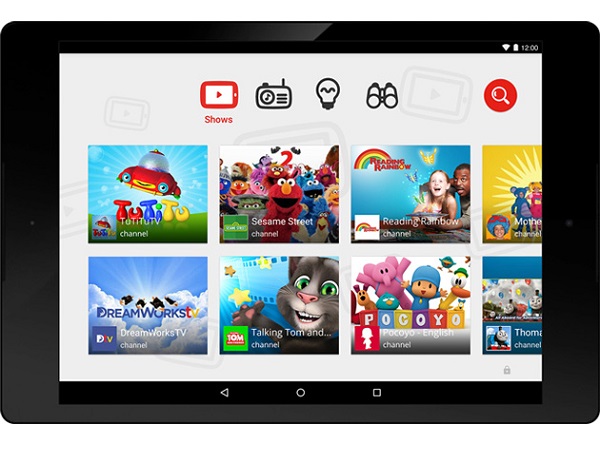YouTube Kids Ads Called Out for Tricking Children
YouTube Kids may not be as innocent as it seems, thanks to advertisements that blur the line between content and hawking products.

Ask almost any exhausted parent, and he or she will agree that kid-centric video apps are a pretty useful invention. YouTube Kids is an app for iOS and Android that targets the preschool set with a wide selection of free clips of cartoons, educational programs and other generally anodyne content. But it may not be as innocent as it seems, thanks to advertisements that blur the line between content and hawking products.
The Georgetown Law Institute for Public Representation, along with eight children's advocacy groups, penned a document to the FTC entitled "Request for Investigation into Google's Unfair and Deceptive Practices in Connection with its YouTube Kids App," and asking the commission to investigate. The 60-page document alleges that the app mixes actual content and commercials in a way that children cannot meaningfully distinguish, and that such behavior would never fly on broadcast or cable TV.
Google advertises YouTube Kids as an app "designed for curious little minds to dive into a world of discovery, learning and entertainment." While its content matches its mission statement, Georgetown Law argues that some of the content blurs the line between entertainment and commercial.
For example, many of the videos available on the service are user-created toy and candy "unboxing" videos, which highlight excited consumers getting their hands on a new product for the first time. These reviewers often receive products directly from the companies they review, and do not disclose this information in a way that very young children can understand.
While these videos are not advertisements in the strictest sense, they would probably violate FCC television standards that disallow children's show hosts from hawking particular products. (Young children, generally speaking, have more trouble differentiating ads from entertainment than their older siblings and parents.)
Branded channels also present something of a challenge. The Lego channel, for example, provides cartoons and webisodes about Lego characters, but also hosts full TV commercials for Lego products. Other companies, like McDonald's, host a mix of narrative content and straight-up ads as well.
Despite speaking out against commercial content, Georgetown Law takes little issue with the actual ads that YouTube Kids shows in-between videos. They tend to be public service announcements for organizations like the U.S. Forestry Service or Adopt U.S. Kids, which, as advertisements go, are fairly inoffensive — arguably even wholesome.
Sign up to get the BEST of Tom's Guide direct to your inbox.
Get instant access to breaking news, the hottest reviews, great deals and helpful tips.
- Best Android-Only Apps You Can't Find on iPhone
- Top Picks for Smartphones
- 15 Best iOS Apps You Can't Find on Android
Marshall Honorof is a senior writer for Tom's Guide. Contact him at mhonorof@tomsguide.com. Follow him @marshallhonorof. Follow us @tomsguide, on Facebook and on Google+.
Marshall Honorof is a senior editor for Tom's Guide, overseeing the site's coverage of gaming hardware and software. He comes from a science writing background, having studied paleomammalogy, biological anthropology, and the history of science and technology. After hours, you can find him practicing taekwondo or doing deep dives on classic sci-fi.
-
d_kuhn It's been many years since I had to look up a real word (internet jargon doesn't count)... but anodyne did it, well played!Reply -
BulkZerker Oh look. YouTube needs to work on their related content for the underage set. How surprising.Reply
What is appauling is this group isn't going after Let's Play channels like pewdiepie... And good letsplay channels like hatfilms, for their adult content. -
eklipz330 yo my cousin's kids look at those unboxing videos ALL day. theyre like 4 and 2. it seems toxic.Reply -
Jesse Vinsant What age group are they referring too? My 5yr old and 6yr old fully understand the difference between an "unboxing" video/commercial and other videos. I don't use the youtube kids app, they just watch youtube videos on my account and are monitored while on the computer.Reply
Honestly, those videos have actually saved me money as they see the toying being played with and decided they don't want it. -
mtarpey Expect your child to have no protection online from exploitive third parties and regulate what they watch. A healthy cynisism of the world goes a long way when parenting.Reply -
husker This article's title should be called out for tricking adults. The comparison to broadcast tv is not fair because tv is regulated based on the older model that the government gave away limited spectrum to broadcast over the airwaves, so that comes with a cost. This is confused by some as an inherent right for government to over manage all media content. Of course I am for protecting children, but I do not see any proof of harm in this article. Even if there were some minor harm, at what point do we trump other rights? For example I guarantee children will be safer from much more dangerous threats if only we would allow daily police inspections of all homes. What, you're not in favor? Why then you must hate children! No one is forced to visit this free website, and parents who want to abdicate responsibility for raising their children to the internet, and then subsequently expect government over-regulation to then shield them from (oh the humanity!) subtle commercialism should not be allowed to diminish internet and society freedom for the rest of us.Reply

